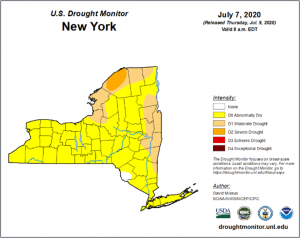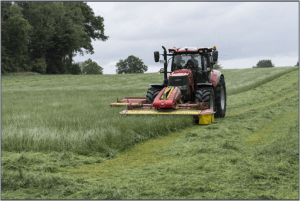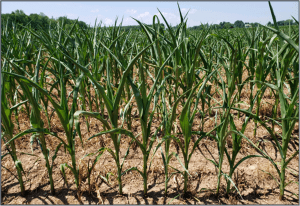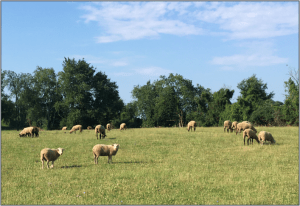Effect of Drought Stress on Corn
 There are many fields of pineappled corn across NWNY. The lack of rainfall is really starting to show and some plants are rolling at 9am. Later planted crops on lighter soils are obviously getting hit the hardest. The U.S. Drought Monitor this week shows all of NWNY at D0, abnormally dry. Hopefully, we all get some of the rainfall predicted for this weekend! Surprisingly, there is still some good-looking corn out there despite the heat and dryness. Unfortunately, some fields are starting to pollinate which is not good during such heat and high temperatures.
There are many fields of pineappled corn across NWNY. The lack of rainfall is really starting to show and some plants are rolling at 9am. Later planted crops on lighter soils are obviously getting hit the hardest. The U.S. Drought Monitor this week shows all of NWNY at D0, abnormally dry. Hopefully, we all get some of the rainfall predicted for this weekend! Surprisingly, there is still some good-looking corn out there despite the heat and dryness. Unfortunately, some fields are starting to pollinate which is not good during such heat and high temperatures.
What kind of yield loss can we expect in these mid to late vegetative stages that are rolling everyday trying to protect themselves? Below is a quick summary of the yield component most affected by environmental stress at different growth stages. The full article can be read at: http://agcrops.osu.edu/newsletter/corn-newsletter/how-can-timing-stress-affect-yield-corn.
- V5-V7: Number of kernel rows. Corn plants are determining the number of kernel rows as early as V5 in some corn hybrids. By V7, the number of kernel rows in the primary ear has been determined for most hybrids.
- V9-VT: Number of potential kernels per row (row length). Each potential kernel comes from one floret on the ear (female flower), and as conditions are more favorable for development the plant will initiate more florets. The number of potential kernels on the ear can be set through late vegetative stages (through V16). Stress during this phase can reduce the yield potential of each plant, and can limit overall yield potential of a field. Flex-ear hybrids may initiate more kernels as compared to a fixed-ear hybrid during this stage.
Handling Heat Stress in Dairy Cows
 Heat stress occurs when cows’ bodies accumulate a heat load that they are unable to dissipate. It can be measured with the Temperature-Humidity Index (THI). The heat stress threshold for dairy cows is 68, with increasing numbers indicating the potential for negative impacts on cow performance. Click here to read more about the Signs and Consequences of Heat Stress & Steps to Reduce Heat Stress.
Heat stress occurs when cows’ bodies accumulate a heat load that they are unable to dissipate. It can be measured with the Temperature-Humidity Index (THI). The heat stress threshold for dairy cows is 68, with increasing numbers indicating the potential for negative impacts on cow performance. Click here to read more about the Signs and Consequences of Heat Stress & Steps to Reduce Heat Stress.
Heat Stress Webinar in English and Spanish
Cornell CALS PRO-DAIRY, CCE of NWNY and CCE of SWNY are offering a webinar on Heat Stress: Key Indicators & Management Strategies in both English and Spanish. The same information will be shared during both webinars. Each webinar is free and registration is not required. Links to join the webinar are also available at: https://prodairy.cals.cornell.edu/webinars/
Heat Stress: Key Indicators and Management Strategies: July 21, 2020 at 12:30 PM. Learn about the negative repercussions of heat stress in dairy cows and calves along with ways to prevent and mitigate it.
Estrés por Calor en Vacas Lecheras: Señales Claves y Estrategias de Manejo: July 22, 2020 at 12:30 PM. Aprenderán sobre las repercusiones negativas del estrés por calor en vacas lecheras y becerros, además de maneras de prevenir y mitigarlo.
Managing Heat Stress for Farmworkers
 Boy it’s hot outside! We are all feeling it. Managers and crew leaders keep an eye on your team. Be sure they have adequate drinking water available at all times. These days are a good time to put some coolers around the farm with water iced down for all to help themselves. Also, be sure to rotate tasks to allow people to beat the heat. Here are some hot weather reminders to help keep your people informed, cool and reduce the risk of heat induced illness:
Boy it’s hot outside! We are all feeling it. Managers and crew leaders keep an eye on your team. Be sure they have adequate drinking water available at all times. These days are a good time to put some coolers around the farm with water iced down for all to help themselves. Also, be sure to rotate tasks to allow people to beat the heat. Here are some hot weather reminders to help keep your people informed, cool and reduce the risk of heat induced illness:
From NY Center for Agricultural Medicine & Health: https://www.nycamh.org/resources/articles.php
From the NYS Department of Health in both Spanish and English: https://www.health.ny.gov/publications/1243/
Adjusting Harvest Management Decisions in a Drought Situation
 Temperatures here in the NWNY region have been averaging mid 80’s to 90’s with increasing humidity and we are seeing the effects of a moderate drought in some areas. It’s DRY! There isn’t much rain predicted for the long range forecast and we are seeing many hay fields stunted with insufficient regrowth for second cutting. Many are asking “how those very drought stressed hay fields should be managed where the limited growth present is old and mature now? Will mowing help to stimulate fall growth—-assuming we get sufficient rainfall soon?”
Temperatures here in the NWNY region have been averaging mid 80’s to 90’s with increasing humidity and we are seeing the effects of a moderate drought in some areas. It’s DRY! There isn’t much rain predicted for the long range forecast and we are seeing many hay fields stunted with insufficient regrowth for second cutting. Many are asking “how those very drought stressed hay fields should be managed where the limited growth present is old and mature now? Will mowing help to stimulate fall growth—-assuming we get sufficient rainfall soon?”
If the crop is “shut down” new growth is unlikely to occur in the event of a rainfall, therefore grasses or mixed stands should be cut high (4”) for any chance of new growth and for management of weeds and pests. For predominant alfalfa stands, if there’s enough growth and the alfalfa is dormant and losing leaves mowing will help gain some salvage feed, but for new seedings of alfalfa or grasses , we recommend refraining from mowing if they’re severely drought stressed. If weeds or pests are a problem, then consider mowing high as mentioned above.
If stands will not yield enough hay or haylage to cover the cost of harvest, and grazing is not feasible, then it will not harm the stand to leave it uncut unless you have severe insect pressure from Potato Leafhopper. This pest is typically a problem during hot, dry conditions and that is what we are seeing in fields at this time. By the time the damage to the plant is visible it’s too late for treatment. These fields should be clipped to control the pest and encourage new growth. Last but not least, “you can’t fertilize yourself out of a drought” according to Quirine Ketterings and Karl Czymmek! Plants require moisture to take up most nutrients and there is a low likelihood of efficient nutrient utilization or crop response to fertilizer during dry conditions.
Farm Financial Management Practices for Unfavorable Economic Conditions

Photo: M. Stanyard / CCE NWNY Team
Sound financial planning and control improve owner’s abilities to manage their businesses during unfavorable economic conditions. Consider the current environment affected by the COVID-19 pandemic, and the lack of rain in many areas. Budgeting is a valuable farm financial management practice for these situations. Click here to learn more about budgeting and its value in managing your farm business.
Spider Mite Injury in Soybeans

Photo: M. Stanyard / CCE NWNY Team
If plants are drought stressed, spider mites are not far behind. We have been seeing low levels of leaf stippling and had our first report of noticeable damage this week. The injury was in spots throughout the field. The silvery spots will eventually turn yellow. Remember, there are no mites per plant thresholds established. Mites reproduce quickly and their injury will be amplified with the drought stress. Once you can see heavy leaf stippling and leaves start to yellow, it’s time to go after them. You can’t alleviate the drought stress but you can mitigate the stress from mite feeding.
There are relatively few products available for the treatment of two-spotted spider mites. Products labeled on soybeans include bifenthrin mixes such as Hero and Argyle, dimethoate and the miticides Agri-Mek and Zeal SC.
Management of Drought on Pastures and Preparing Livestock for Drought Conditions

Photo: B. Waite / CCE NWNY Team
Pastures have pretty much stopped growing. For quicker recovery when rain comes, move livestock off pastures to barnyards, or at least a sacrifice area with shade. The shorter the grazed height, the more the soil will heat up and slow regrowth. Livestock will need to have more water available at all times. Mike Baker, Cornell’s beef cattle extension specialist has compiled a list of resources found here: https://blogs.cornell.edu/beefcattle/producer-resources/drought-resources/. They are primarily for beef, but pertain to other species as well.


